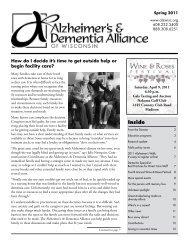Social Security Disability Insurance and young onset dementia: A ...
Social Security Disability Insurance and young onset dementia: A ...
Social Security Disability Insurance and young onset dementia: A ...
Create successful ePaper yourself
Turn your PDF publications into a flip-book with our unique Google optimized e-Paper software.
earliest manifestation, quickly followed by learning <strong>and</strong> language impairments. Because people with<br />
early-<strong>onset</strong> AD are often in the work force it is not uncommon for the disease to first manifest as a<br />
decline or loss in their ability to perform work related activities. Depression is also a common early<br />
symptom.<br />
Diagnostic testing:<br />
The diagnosis of early-<strong>onset</strong> AD is based on the combination of clinical <strong>and</strong> family history;<br />
neurological, cognitive, or neuropsychological examination; <strong>and</strong> neuroimaging. Pertinent clinical<br />
information includes history of <strong>onset</strong> <strong>and</strong> description of cognitive <strong>and</strong> functional impairments at<br />
home <strong>and</strong> at work. Currently, there is no specific clinical or laboratory diagnostic test for early-<strong>onset</strong><br />
(or late-<strong>onset</strong>) AD <strong>and</strong> at present, the diagnosis can only be confirmed by brain biopsy or<br />
postmortem examination of the brain. A decline in Mini-Mental Status Examination (MMSE)<br />
scores over time is a likely indicator of possible <strong>dementia</strong>. Neuroimaging, such as computerized<br />
tomography (CT) or magnetic resonance imaging (MRI) is useful to demonstrate changes in the<br />
brain <strong>and</strong> to exclude other causes of <strong>dementia</strong>.<br />
Mixed Dementia is <strong>dementia</strong> caused by multiple etiologies including; Vascular <strong>dementia</strong>,<br />
Alzheimer’s disease, Parkinson’s <strong>dementia</strong>, Diffuse Lewy-body <strong>dementia</strong>, Frontotemporal <strong>dementia</strong><br />
(Pick’s disease), Huntington’s <strong>dementia</strong>; Prion <strong>dementia</strong>; Progressive Supranuclear Palsy (PSP).<br />
Mixed <strong>dementia</strong>s are conditions with more than one etiology for the <strong>dementia</strong>. The combination of<br />
the Vascular <strong>dementia</strong> <strong>and</strong> Alzheimer’s disease is the most common form. Mixed <strong>dementia</strong>s are<br />
characterized by progressive <strong>and</strong> persistent intellectual decline compromising at least two spheres of<br />
cognition (i.e. memory, language, orientation, attention, executive abilities, etc). These individuals<br />
may also have motor <strong>and</strong> gait impairment, affective disturbances <strong>and</strong> sleep disturbances.<br />
Diagnostic tests may include:<br />
The diagnoses of mixed <strong>dementia</strong>s are based on a clinical history of cognitive decline, neurologic<br />
<strong>and</strong> cognitive/neuropsychologic examination, <strong>and</strong> neuroimaging. Pertinent clinical information<br />
includes history of <strong>onset</strong> <strong>and</strong> description of cognitive <strong>and</strong> functional impairments at home <strong>and</strong> at<br />
work. History of a pervious stroke(s) adds to the likelihood of the diagnosis, but is not required.<br />
Currently, there is no specific clinical or laboratory test fo the diagnosis of Alzheimer’s disease <strong>and</strong><br />
its diagnosis can only be confirmed by brain biopsy or postmortem examination of the brain.<br />
Neuroimaging, i.e. computerized tomography (CT0or magnetic resonance imaging (MRI) is useful<br />
to demonstrate vascular lesions such as infarcts <strong>and</strong> lacunes, <strong>and</strong> to exclude other causes of<br />
<strong>dementia</strong>, some of which may be treatable.<br />
Primary Progressive Aphasia (PPA) is a type of <strong>dementia</strong> characterized by slow erosion of<br />
language (aphasia) over a two year period. It affects the language <strong>and</strong> semantic functioning<br />
(semantic <strong>dementia</strong>) <strong>and</strong> eventually progresses to amnesia. People with primary progressive aphasia<br />
may have trouble naming objects or may misuse word endings, verb tenses, conjunctions <strong>and</strong><br />
pronouns. Primary progressive aphasia is a type of frontotemporal <strong>dementia</strong>, a group of related<br />
disorders in the frontal or temporal lobes of the brain. Most people with primary progressive aphasia<br />
maintain ability to take care of themselves, pursue hobbies, <strong>and</strong>, in some instances, remain<br />
employed.<br />
Diagnostic tests may include:<br />
• Clinical exam,<br />
• Speech/language evaluation that examines word retrieval, sentence formulation, <strong>and</strong> auditory<br />
comprehension skills,








